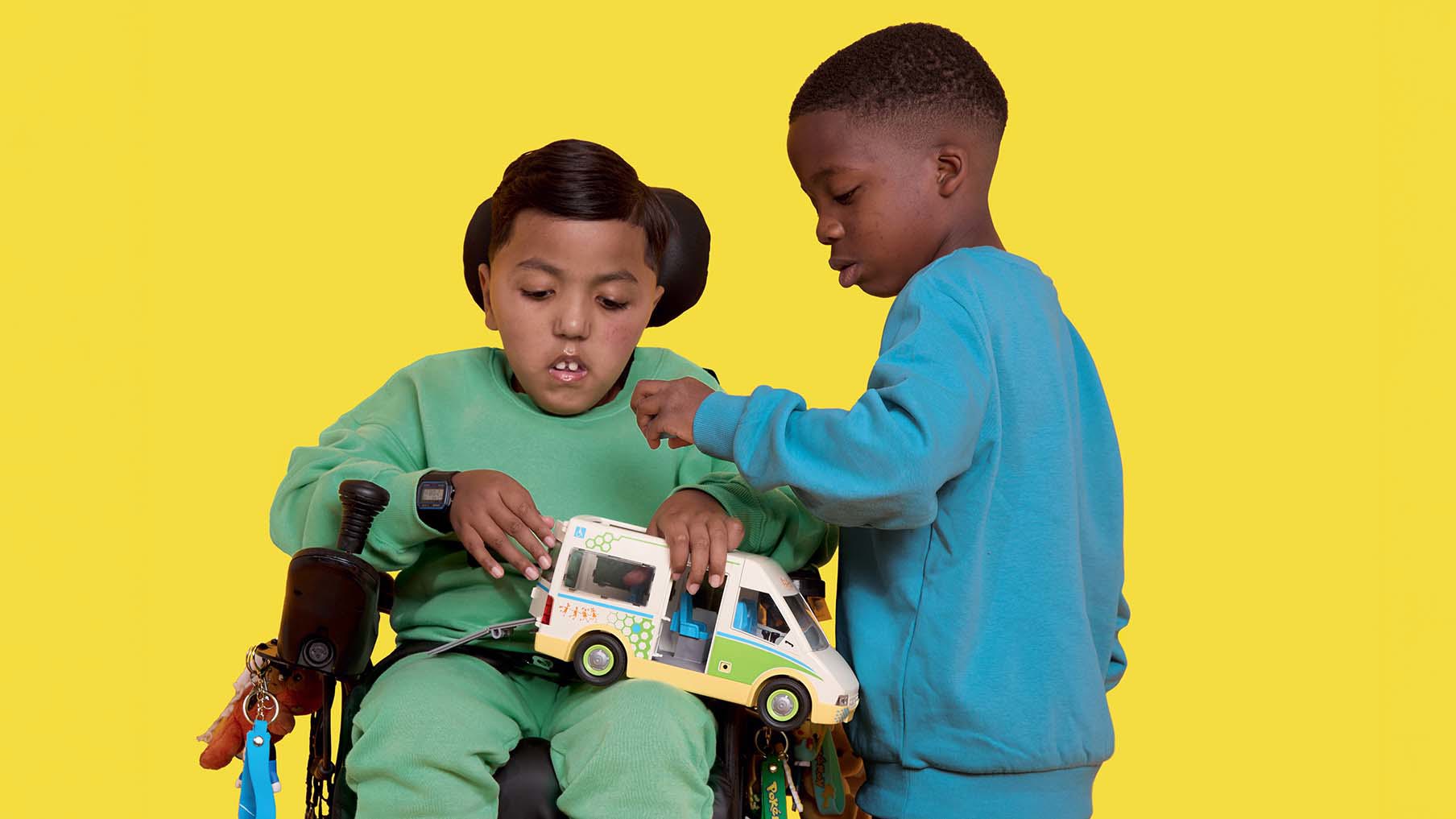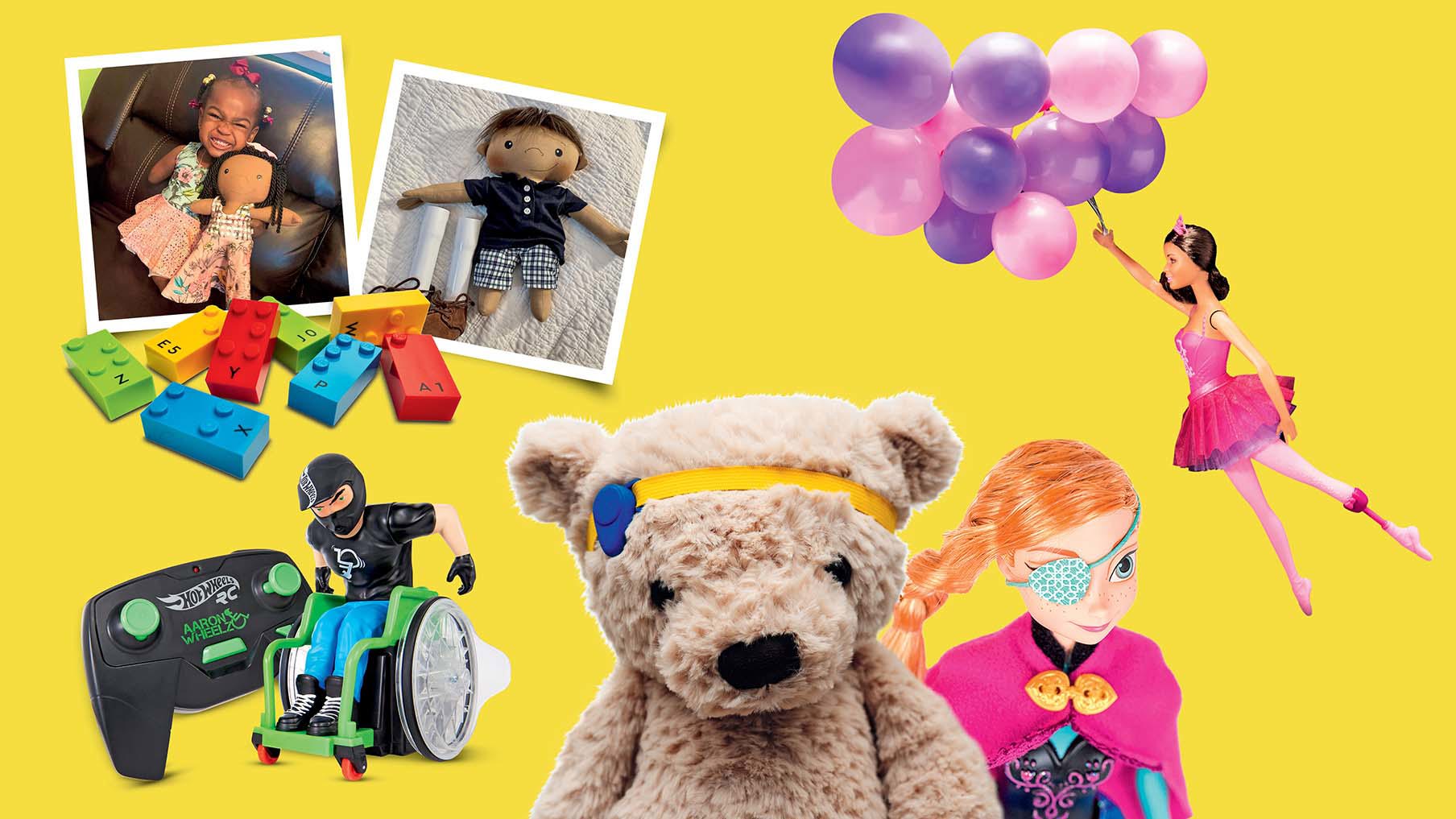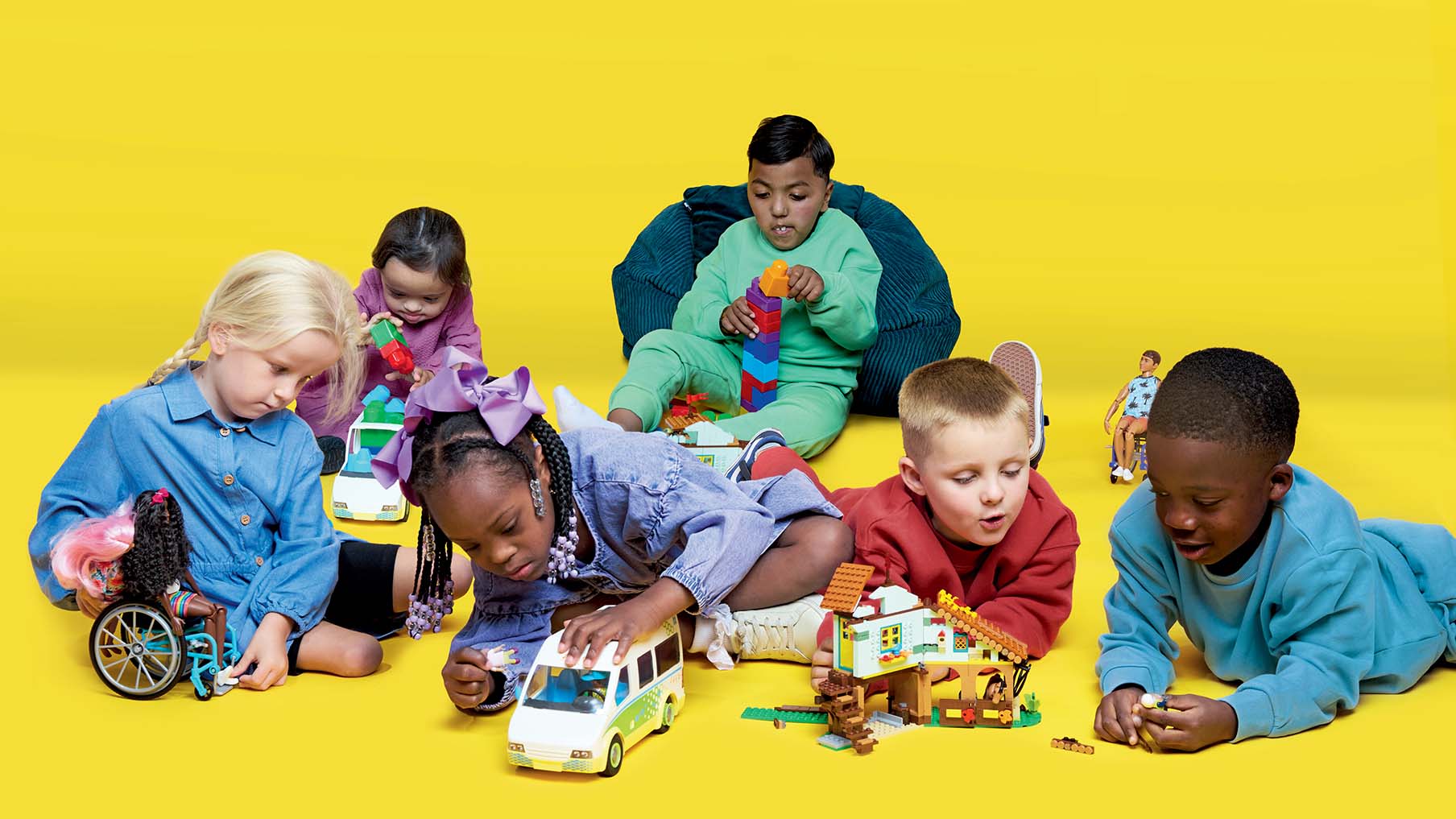“My favourite toy looks like me,” says four–year–old cover star Posie with a beaming smile as she models with a Barbie doll, who has a prosthetic leg. “Watching Posie play with inclusive toys allows her to accept who she is and that’s important,” adds her dad Dominic Sadler–Smith.
Lifestyle brought together six children (disabled and non–disabled) to play with a range of toys that normalise disability – such as Barbies, Lego sets, Playmobil and Lottie Dolls. The aim? To celebrate the growing range of inclusive toys because, for decades, 240 million children sadly didn’t have a toy that represented them.
Children and parents didn’t know that there were so many disabled toys available. Tunde Alukwu, mum to cover star Abigail, says: “There are so many more inclusive toys than I was aware of. If we all had these types of toys growing up, there would be less ableism because they bring awareness and promote understanding.”
More than just a toy
Toys have the power to perpetuate or eradicate stereotypes. They play an essential role in representing difference and shaping children’s attitudes towards diversity and inclusion. But it’s only over the past five years that toy manufacturers have taken this responsibility seriously.
Barbie Fashionista in a Wheelchair was launched in 2019 (the first Barbie with a disability). The Barbie Fashionista line is described by Mattel as an inclusive range of dolls “designed to reflect the world kids see today.” Now there are Barbie and Ken dolls with hearing aids, Down syndrome, vitiligo, that use a wheelchair, have prosthetic limbs, and Barbies without hair. Most recently, Mattel launched the first blind Barbie.
Positive representation in toys helps children feel valued and seen, and increases self-esteem and confidence. Barbie is much more than just a doll: “she represents self–expression and can create a sense of belonging,” says Krista Berger, senior vice–president of Barbie and the global head of dolls.
Lego and Playmobil are also part of this revolution. Playmobil sells sets with ramps, elevators and accessible bathrooms, a Paralympic Javelin Thrower with prosthetic limb, and accessories like walking sticks. Lego, meanwhile, sells figures with vitiligo, ADHD, Down syndrome, figurines in wheelchairs and Braille sets.
Not only do these toys normalise difference, but they also dismantle stereotypes of disability being synonymous with medical settings, old age, baddies and geeks.
Donna, mum to cover star Sakina, adds: “Inclusive toys teach children at a young age to respect who may be different. The Barbie with Down syndrome means my child has something that represents her. We’re not all the same. It’s nice that my child has a doll that is the same as her and she can really relate to.”
There’s a wider impact, too. Children without disabilities learn to value differences and develop empathy. Research has found that if a non–disabled child plays with a disabled toy for three minutes, their friendship intentions towards a disabled child improved. This proved true during our photoshoot. All the children played together irrespective of their disabilities and found different ways to communicate with each other. They bonded over their shared love for toys. King Nzekwue, six, says: “I had so much fun today playing with Noah, he’s my new best friend”.
Inclusive toys can also encourage children to ask questions and learn more about disabilities in a positive and curious way. 19 Melek McGill, Theodore’s mum agrees, saying that playing with dolls like blind Barbie and amputee Ken at the photoshoot opened his eyes: “He has asked a lot of questions that he probably wouldn’t have asked if we hadn’t been here, so it brings awareness.”

Thinking outside the toy box
There were earlier attempts at creating toys with a disability; way back in 1997, Mattel released Share–a–Smile Becky, who used a pink wheelchair. Thousands of dolls were sold, but her wheelchair couldn’t enter the Dreamhouse, use its lift or enjoy various accessories. This attempt at inclusion became a very public and high–profile example of ableist thinking. Becky disappeared without a trace.
Almost 20 years later, Rebecca Atkinson founded Toylikeme.org, an arts and play not–for–profit organisation to encourage more representation in toys, after she realised – when tidying up her own children’s toys – that there were no representations of disability. Rebecca, who was born partially deaf and later developed retinitis pigmentosa, meaning she uses a guide dog and cane, says: “It was a lightbulb moment. I dug a bit deeper and found you could get some wheelchair figures, but they were all grandparents with grey hair, the wheelchairs were grey and boring, or were in a hospital set and it was somebody who’d had a footballing accident and broken a leg – it didn’t speak to children who had lifelong disabilities.”
She took matters into her own hands and “made a hot pink cochlear implant, put it on a Tinker bell doll, took a high–quality image and put it online”. It went viral. The story was picked up by media outlets from the BBC to the Guardian to Al Jazeera, and ToyLikeMe was born. On a roll, Rebecca and her collaborators, Melissa Mostyn and Karen Newell, made a Lego wheelchair skate–park and gave Playmobil figures waggy–tailed guide dogs, among other creations. They started a change.org petition asking companies to do the work themselves, and the following year, Lego unveiled their first–ever wheelchair–using mini–figure.
Irish brand Lottie were the first to create a doll, Mia, with a cochlear implant. “That was pivotal because after that the big brands like Barbie really jumped on it,” explains Rebecca. Lottie also produce bald dolls, an Autism and ADHD–focused doll, a short statured doll, and are working on a type 21 Down syndrome doll. It’s something Rebecca wishes she experienced as a child: “I never saw a deaf child in a book or a deaf toy – you couldn’t see it anywhere, apart from in charity narratives. The impact of that was that you [considered yourself] of low value as a deaf person. Children form their identity and self–esteem based on how the world around them is responding to them, so if we’re constantly being told that we’re of low value, invisible, we internalise that.
“I internalised a sense of shame in my hearing aids; I always wore my hair down so that nobody would see them. I was masking to fit in.”
ToyLikeMe now uses the magic of play to start playful conversations about disability in schools. Rebecca also developed Mixmups, a preschool animation programme that shows disability as a natural part of life. She says: “For people to see their minority experience represented in a mainstream, cultural setting is massive for self–esteem, sense of inclusion and value.”
Spotting the gap
Amy Jandrisevits also blazed a trail. As a US–based paediatric social worker, she uses play therapy with children with cancer. Amy spotted the lack of representation in toys more than two decades ago. “The essence of play therapy is that you want the child to look at a doll and say, ‘This is me, this is what they’re going to do to me, and this is what it’s going to look like’. There wasn’t a selection of dolls that looked like the kids who played with them. There was the blonde, blue–eyed white doll, and the same doll painted brown with black hair,” she says.
Amy created A Doll Like Me a non–profit organisation, where she custom makes every doll to look like the child who will receive it. “I started as making dolls for fun. A friend saw one and thought it looked like her daughter, except her daughter had had her leg amputated, so she asked if I could make that same doll, but with an amputated leg. She shared it on social media and in two months I had 200 orders for dolls with limb differences. I realised there was a real need, and I had a skillset to fill it. It became my mission.
“I’ve made well over 1,000 dolls. This is something that impacts kids in a very positive way, particularly in a society where we place a lot of value on your physical appearance. You can tell kids until you’re blue in the face, ‘You’re beautiful, we’re all different’ but I don’t know that they can feel that because mainstream media is so powerful.”

Amy has made so many dolls that you would not find on the shelf, such as dolls with albinism, facial differences and giant congenital nevus (large pigmented skin lesions present at birth). Just a quick scroll through Amy’s Instagram page and you can see the wonderful pictures and heartfelt messages from parents and children. “It’s important for all kids to see diversity in dolls,” says Amy. “A number of kids have said, ‘I’m going to take my doll to school tomorrow so the kids can see that I’m not the only one that looks like this’.”
The impact of positive representation is life changing. Shankar Jalota, author of The Adventures Of The Vitiligo Man says, “if I’d had a vitiligo toy or book when I was younger, I have no doubt it would have helped me see my vitiligo in a more positive light. I didn’t see any positive material, which made me hate the skin I was in.” He’s now producing a soft toy to accompany his book. He adds that, “If we are able to celebrate differences at a young age, it shapes who we become as adults.”
Journalist, content creator and Motability Scheme Ambassador Lucy Edwards feels similarly. Talking about Blind Barbie, she says: “I lost sight in my right eye at 11. Self–acceptance is what allowed me to move on, to stop thinking about finding a cure and ‘fixing’ myself. If I’d played with the most popular doll in the world with a disability just like mine, I would have felt so much more confident about going blind.”
Future progress
While progress should be wholeheartedly celebrated, more could be done and more disabilities could be represented.
Aaron Guiver, managing director at Skylarks, a charity that provides activities and therapies for children with disabilities and additional needs – including cover stars Noah and Sakina – says: “Manufacturers should collaborate with children and educators who have real–life experiences as co–creators. It’s important to not only design toys inclusively, but also incorporate diversity into the branding and storylines of the toys.”
Rebecca adds: “Part of the problem is that disabled people haven’t been in the position to be those designers so you get that ableist non–disabled lens coming out in the design.”
There’s a gap in the market for more Barbies, perhaps: “It would be great to have a doll who is a double amputee like Posie,” says Dominic.
Sophie Dawson, mum to two daughters who are blind, calls for toys with disabilities to be part of larger play sets rather than something you buy separately: “this would also help reach a wider audience of children who may not specifically buy a disabled doll but would play with it, if it was included with a play set. It would be great if all toy makers added Braille to the packaging as standard, too.”
Manufacturers also need to address availability as toys with disabilities are often limited edition, like Hot Wheelz Aaron Wheelz Wheely chair. This in turn makes them more costly.
As Rebecca points out, it’s she and her generation that have filled the void they felt growing up and that work needs to continue because “if the cultural sector starts to reflect the real population, you get that sense of acceptance.”

WE LOVE THAT BARBIE IS BLIND LIKE US
Sophie Dawson’s daughters Alma, nine, and Suzie, seven, have an eye condition called Lebers congenital amaurosis, and have been blind since birth. They all love the latest blind Barbie doll.
Sophie says: “To be able to go to a shop and pick up a Barbie doll that represents you means everything to us, as the girls feel included.
“Previously we would have had to make, and add, a cane to a doll as an afterthought, but with Blind Barbie the girls were able to see themselves represented straight out of the box!”
Alma loves Barbie’s cane as it’s just like hers. “I like that you can sweep her cane across the floor because her arm moves,” she says. “And I like that the box said ‘Barbie’ in Braille.”
Suzie adds: “I was so happy they have made a Barbie with a cane, and she has glasses too, like me. I like her sparkly skirt, too!”
Photos: Stephen Williams; A Doll Like Me, Inc; Mattel; Toy Like Me; Lego; Beth Moseley/Toy Like Me; Courtesy of Sophie Dawson





